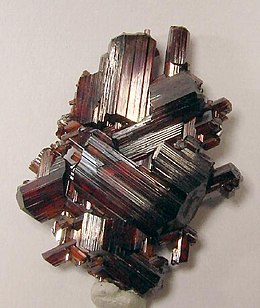| Rutile | |
|---|---|
 | |
| General | |
| Category | Oxide minerals |
| Formula (repeating unit) | TiO2 |
| IMA symbol | Rt[1] |
| Strunz classification | 4.DB.05 |
| Crystal system | Tetragonal |
| Crystal class | Ditetragonal dipyramidal (4/mmm) H-M symbol: (4/m 2/m 2/m) |
| Space group | P42/mnm |
| Unit cell | a = 4.5937 Å, c = 2.9587 Å; Z = 2 |
| Identification | |
| Color | Brown, reddish brown, blood red, red, brownish yellow, pale yellow, yellow, pale blue, violet, rarely grass-green, grayish black; black if high in Nb–Ta |
| Crystal habit | Acicular to Prismatic crystals, elongated and striated parallel to [001] |
| Twinning | Common on {011}, or {031}; as contact twins with two, six, or eight individuals, cyclic, polysynthetic |
| Cleavage | {110} good, {100} moderate, parting on {092} and {011} |
| Fracture | Uneven to sub-conchoidal |
| Mohs scale hardness | 6.0–6.5 |
| Luster | Adamantine to metallic |
| Streak | Bright red to dark red |
| Diaphaneity | Opaque, transparent in thin fragments |
| Specific gravity | 4.23 increasing with Nb–Ta content |
| Optical properties | Uniaxial (+) |
| Refractive index | nω = 2.613, nε = 2.909 (589 nm) |
| Birefringence | 0.296 (589 nm) |
| Pleochroism | Weak to distinct brownish red-green-yellow |
| Dispersion | Strong |
| Fusibility | Fusible in alkali carbonates |
| Solubility | Insoluble in acids |
| Common impurities | Fe, Nb, Ta |
| Other characteristics | Strongly anisotropic |
| References | [2][3][4][5] |
Rutile is an oxide mineral composed of titanium dioxide (TiO2), the most common natural form of TiO2. Rarer polymorphs of TiO2 are known, including anatase, akaogiite, and brookite.
Rutile has one of the highest refractive indices at visible wavelengths of any known crystal and also exhibits a particularly large birefringence and high dispersion. Owing to these properties, it is useful for the manufacture of certain optical elements, especially polarization optics, for longer visible and infrared wavelengths up to about 4.5 micrometres. Natural rutile may contain up to 10% iron and significant amounts of niobium and tantalum.
Rutile derives its name from the Latin rutilus ('red'), in reference to the deep red color observed in some specimens when viewed by transmitted light. Rutile was first described in 1803 by Abraham Gottlob Werner using specimens obtained in Horcajuelo de la Sierra, Madrid (Spain),[6] which is consequently the type locality.
https://en.wikipedia.org/wiki/Rutile
No comments:
Post a Comment